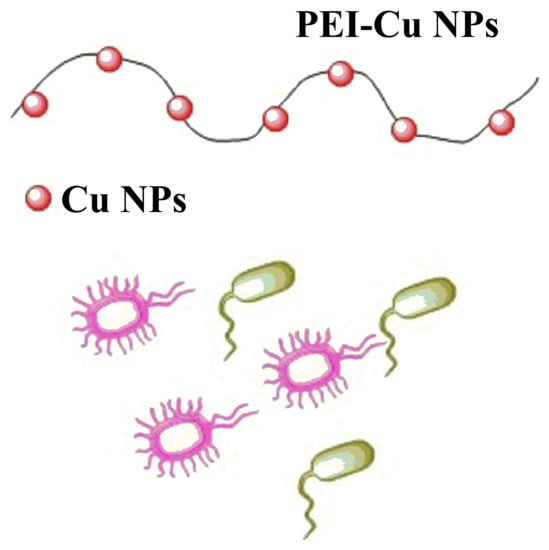Synthesis of Copper Nanoparticles Stabilized with Organic Ligands and Their Antimicrobial Properties
Abstract
:1. Introduction
2. Materials and Methods
2.1. Materials
2.2. Synthesis of Cu NPs
2.3. Characterization Techniques
2.4. Antibacterial Activity
3. Results and Discussion
3.1. X-ray Diffraction Analysis of Cu NPs
3.2. Thermogravimetric Analysis (TGA)
3.3. Transmission Electron Microscopy Analysis (TEM)
3.4. Fourier Transform Infrared Spectroscopy Analysis (FTIR)
3.5. Zeta Potential Analysis of Cu NPs
3.6. Antibacterial Activity of Cu-PEI/AABT NPs
4. Conclusions
Author Contributions
Funding
Institutional Review Board Statement
Informed Consent Statement
Data Availability Statement
Acknowledgments
Conflicts of Interest
References
- García, A.; Rodríguez, B.; Giraldo, H.; Quintero, Y.; Quezada, R.; Hassan, N.; Estay, H. Copper-Modified Polymeric Membranes for Water Treatment: A Comprehensive Review. Membranes 2021, 11, 93. [Google Scholar] [CrossRef] [PubMed]
- Van Doremalen, N.; Bushmaker, T.; Morris, D.H.; Holbrook, M.G.; Gamble, A.; Williamson, B.N.; Tamin, A.; Harcourt, J.L.; Thournburg, N.J.; Gerber, S.I.; et al. Aerosol and surface stability of SARS-CoV-2 as compared with SARS-CoV-1. N. Engl. J. Med. 2020, 382, 1564–1567. [Google Scholar] [CrossRef] [PubMed]
- Zuniga, J.M.; Cortes, A. The role of additive manufacturing and antimicrobial polymers in the COVID-19 pandemic. Exp. Rev. Med. Dev. 2020, 17, 477–481. [Google Scholar] [CrossRef]
- Kumar, S.; Karmacharya, M.; Joshi, S.R.; Gulenko, O.; Park, J.; Kim, G.-H.; Cho, Y.-K. Photoactive Antiviral Face Mask with Self-Sterilization and Reusability. Nano Lett. 2021, 21, 337–343. [Google Scholar] [CrossRef] [PubMed]
- Quiterio-Gutiérrez, T.; Ortega-Ortiz, H.; Cadenas-Pliego, G.; Hernández-Fuentes, A.D.; Sandoval-Rangel, A.; Benavides-Mendoza, A.; Cabrera-de la Fuente, M.; Juárez-Maldonado, A. The Application of Selenium and Copper Nanoparticles Modifies the Biochemical Responses of Tomato Plants under Stress by Alternaria solani. Int. J. Mol. Sci. 2019, 20, 1950. [Google Scholar] [CrossRef] [Green Version]
- Pérez-Labrada, F.; López-Vargas, E.R.; Ortega-Ortiz, H.; Cadenas-Pliego, G.; Benavides-Mendoza, A.; Juárez-Maldonado, A. Responses of Tomato Plants under Saline Stress to Foliar Application of Copper Nanoparticles. Plants 2019, 8, 151. [Google Scholar] [CrossRef] [PubMed] [Green Version]
- Hernández-Hernández, H.; Quiterio-Gutiérrez, T.; Cadenas-Pliego, G.; Ortega-Ortiz, H.; Hernández-Fuentes, A.D.; Cabrera de la Fuente, M.; Valdés-Reyna, J.; Juárez-Maldonado, A. Impact of Selenium and Copper Nanoparticles on Yield, Antioxidant System, and Fruit Quality of Tomato Plants. Plants 2019, 8, 355. [Google Scholar] [CrossRef] [Green Version]
- González-García, Y.; Cárdenas-Álvarez, C.; Cadenas-Pliego, G.; Benavides-Mendoza, A.; Cabrera-de-la-Fuente, M.; Sandoval-Rangel, A.; Valdés-Reyna, J.; Juárez-Maldonado, A. Effect of Three Nanoparticles (Se, Si and Cu) on the Bioactive Compounds of Bell Pepper Fruits under Saline Stress. Plants 2021, 10, 217. [Google Scholar] [CrossRef]
- Bashir, F.; Irfan, M.; Ahmad, T.; Iqbal, J.; Butt, M.T.; Sadef, Y.; Moniruzzaman, M. Efficient utilization of low cost agro materials for incorporation of copper nanoparticles to scrutinize their antibacterial properties in drinking water. Environ. Technol. Innov. 2020, 21, 101228. [Google Scholar] [CrossRef]
- Garcia, K.A.; Peroja KA, G.; Tuberon NA, L.; Cambiador CJ, B.; Cid-Andres, A.P. Metal incorporated Philippine Abaca fiber (Manila hemp) as a potential novel filter for water disinfection. J. Phys. Conf. Ser. 2021, 1, 012064. [Google Scholar] [CrossRef]
- Wang, B.; Chen, S.; Nie, J.; Zhu, X. Facile method for preparation of superfine copper nanoparticles with high concentration of copper chloride through photoreduction. R. Soc. Chem. Adv. 2014, 4, 27381–27388. [Google Scholar] [CrossRef]
- Navarro-Rosales, M.; Ávila-Orta, C.A.; Neira-Velázquez, M.G.; Ortega-Ortiz, H.; Hernández-Hernández, E.; Solís-Rosales, S.G.; España-Sánchez, B.L.; Gónzalez-Morones, P.; Jímenez-Barrera, R.M.; Sánchez-Valdes, S.; et al. Effect of Plasma Modification of Copper Nanoparticles on their Antibacterial Properties. Plasma Process. Polym. 2014. [Google Scholar] [CrossRef]
- Tamayo, L.; Azócar, M.; Kogan, M.; Riveros, A.; Páez, M. Copper-polymer nanocomposites: An excellent and cost-effective biocide for use on antibacterial surfaces. Mater. Sci. Eng. C 2016, 69, 1391–1409. [Google Scholar] [CrossRef]
- España-Sánchez, B.L.; Ávila-Orta, C.A.; Neira-Velásquez, M.G.; Solís-Rosales, S.G.; González-Morones, P. Preparation of Polymer Nanocomposites with Enhanced Antimicrobial Properties. Mater. Res. Soc. 2012, 1479, 57–62. [Google Scholar] [CrossRef]
- Milani, M.A.; Quijada, R.; Basso, N.R.S.; Graebin, A.P.; Galland, G.B. Influence of the Graphite Type on the Synthesis of Polypropylene/Graphene Nanocomposites. J. Polym. Sci. A Polym. Chem. 2012, 50, 3598–3605. [Google Scholar] [CrossRef]
- Harishchandra, B.D.; Pappuswamy, M.; PU, A.; Shama, G.; Arumugam, V.A.; Periyaswamy, T.; Sundaram, R. Copper Nanoparticles: A Review on Synthesis, Characterization and Applications. Asian Pac. J. Cancer Biol. 2020, 5, 201–210. [Google Scholar] [CrossRef]
- Pulkkinen, P.; Shan, J.; Leppanen, K.; Kansakoski, A.; Laiho, A.; Jarn, M.; Tenhu, H. Poly(ethylene imine) and Tetraethylenepentamine as Protecting Agents for Metallic Copper Nanoparticles. ACS Appl. Mater. Interf. 2009, 1, 519–525. [Google Scholar] [CrossRef]
- Pérez-Alvarez, M.; Cadenas-Pliego, G.; Pérez-Camacho, O.; Comparán-Padilla, V.E.; Cabello-Alvarado, C.J.; Saucedo-Salazar, E. Green Synthesis of Copper Nanoparticles Using Cotton. Polymers 2021, 13, 1906. [Google Scholar] [CrossRef]
- Gawande, M.B.; Goswami, A.; Felpin, F.X.; Asefa, T.; Huang, X.; Silva, R.; Zou, X.; Zboril, R.; Varma, R.S. Cu and Cu-Based Nanoparticles: Synthesis and Applications in Catalysis. Chem. Rev. 2016, 116, 3722–3811. [Google Scholar] [CrossRef] [Green Version]
- Sierra-Ávila, R.; Pérez-Álvarez, M.; Cadenas-Pliego, C.; Ávila-Orta, C.A.; Betancourt-Galindo, R.; Jiménez-Regalado, E.; Jiménez-Barrera, R.M.; Martínez-Colunga, J.G. Synthesis of Copper Nanoparticles Coated with Nitrogen Ligands. J. Nanomater. 2014, 1–8. [Google Scholar] [CrossRef] [Green Version]
- Reverberi, A.P.; Salerno, M.; Lauciello, S.; Fabiano, B. Synthesis of Copper Nanoparticles in Ethylene Glycol by Chemical Reduction with Vanadium (+2) Salts. Materials 2016, 9, 809. [Google Scholar] [CrossRef]
- Lai, D.; Liu, T.; Jiang, G.; Chen, G. Synthesis of Highly Stable Dispersions of Copper Nanoparticles Using Sodium Hypophosphite. J. Appl. Polym. Sci. 2013, 1443–1449. [Google Scholar] [CrossRef]
- Wang, Y.; Asefa, T. Poly(allylamine)-Stabilized Colloidal Copper Nanoparticles: Synthesis, Morphology, and Their Surface-Enhanced Raman Scattering Properties. Langmuir 2010, 26, 7469–7474. [Google Scholar] [CrossRef] [PubMed]
- Wang, Y.; Biradar, A.V.; Wang, G.; Sharma, K.K.; Duncan, C.T.; Rangan, S.; Asefa, T. Controlled Synthesis of Water-Dispersible Faceted Crystalline Copper Nanoparticles and Their Catalytic Properties. Chem. Eur. J. 2010, 16, 10735–10743. [Google Scholar] [CrossRef]
- Shahmiri, M.; Ibrahim, N.A.; Zainuddin, N.; Asim, N.; Bakhtyar, B.; Zaharim, A.; Sopian, K. Effect of pH on the Synthesis of CuO Nanosheets by Quick Precipitation Method. WSEAS Trans. Environ. Dev. 2013, 2, 137–146. [Google Scholar]
- Shu, X.; Feng, J.; Liao, J.; Zhang, D.; Peng, R.; Shi, Q.; Xie, X. Amorphous carbon-coated nano-copper particles: Novel synthesis by Sol–Gel and carbothermal reduction method and extensive characterization. J. Alloys Compd. 2020, 848, 156556. [Google Scholar] [CrossRef]
- Sierra-Ávila, R.; Pérez-Álvarez, M.; Cadenas-Pliego, G.; Comparán-Padilla, V.E.; Ávila-Orta, C.A.; Pérez-Camacho, O.; Jiménez-Regalado, E.; Hernández-Hernández, E.; Jiménez-Barrera, R.M. Synthesis of Copper Nanoparticles Using Mixture of Allylamine and Polyallylamine. J. Nanomater. 2015, 16, 140. [Google Scholar] [CrossRef] [Green Version]
- Jardón-Maximino, N.; Pérez-Alvarez, M.; Sierra-Ávila, R.; Ávila-Orta, C.A.; Jiménez-Regalado, E.; Bello, A.M.; González-Morones, P.; Cadenas-Pliego, P. Oxidation of Copper Nanoparticles Protected with Different Coatings and Stored under Ambient Conditions. J. Nanomater. 2018, 2018, 9512768. [Google Scholar] [CrossRef] [Green Version]
- Xia, T.; Guan, Y.; Yang, M.; Xiong, W.; Wang, N.; Zhao, S.; Guo, C. Synthesis of polyethylenimine modified Fe3O4 nanoparticles withimmobilized Cu2+ for highly efficient proteins adsorption. Colloid. Surf. A: Physicochem. Eng. Asp. 2014, 443, 552–559. [Google Scholar] [CrossRef]
- Deze, E.G.; Papavasiliou, A.; Papageorgiou, S.K.; Katsaros, F.K.; Kouvelos, E.P.; Romanos, G.E.; Boukos, N.; Xin, Q.; Nyalosaso, J.L.; Cool, P. Metal loaded nanoporous silicas with tailor-made properties through hyperbranched polymer assisted templating approaches. Microporous Mesoporous Mater. 2016, 235, 107–119. [Google Scholar] [CrossRef]
- Ting-Ting, X.; Chun-Zhao, L.; Jian-Hua, H.; Chen, G. Improved performance of immobilized laccase on amine-functioned magnetic Fe3O4 nanoparticles modified with polyethylenimine. Chem. Eng. J. 2016, 295, 201–206. [Google Scholar] [CrossRef]
- Tsiourvas, D.; Papavasiliou, A.; Deze, E.G.; Papageorgiou, S.K.; Katsaros, F.K.; Romanos, G.E.; Poulakis, E.; Philippopoulos, C.J.; Xin, Q.; Cool, P. A Green Route to Copper Loaded Silica Nanoparticles Using Hyperbranched Poly(Ethylene Imine) as a Biomimetic Template: Application in Heterogeneous Catalysis. Catalysts 2017, 7, 390. [Google Scholar] [CrossRef] [Green Version]
- Bogdanović, U.; Lazić, V.; Vodnik, V.; Budimir, M.; Marković, Z.; Dimitrijević, S. Copper nanoparticles with high antimicrobial activity. Mater. Lett. 2014, 128, 75–78. [Google Scholar] [CrossRef]
- Arendsen, L.P.; Thakar, R.; Sultan, A.H. The Use of Copper as an Antimicrobial Agent in Health Care, Including Obstetrics and Gynecology. Clin. Microbiol. Rev. 2019, 32, e00125-18. [Google Scholar] [CrossRef] [PubMed]
- Jardón-Maximino, N.; Cadenas-Pliego, G.; Ávila-Orta, C.; Comparán-Padilla, V.; Lugo-Uribe, L.; Pérez-Alvarez, M.; Tavizón, S.; Santillán, G. Antimicrobial Property of Polypropylene Composites and Functionalized Copper Nanoparticles. Polymers 2021, 13, 1694. [Google Scholar] [CrossRef] [PubMed]
- Damm, C.; Münstedt, H.; Rösch, A. The antimicrobial efficacy of polyamide 6/silver-nano- and microcomposites. Mater. Chem. Phys. 2008, 108, 61–66. [Google Scholar] [CrossRef]
- Mott, D.; Galkowski, J.; Wang, L.; Luo, A.J.; Zhong, C.-J. Synthesis of Size-Controlled and Shaped Copper Nanoparticles. Langmuir 2007, 23, 5740–5745. [Google Scholar] [CrossRef]
- Wang, W.; Wang, G.; Wang, X.; Zhan, Y.; Liu, Y.; Zheng, C. Synthesis and Characterization of Cu2O Nanowires by a Novel Reduction Route. Adv. Mater. 2002, 12, 67–69. [Google Scholar] [CrossRef]
- Langford, J.I.; Wilson, A.J.C. Scherrer after sixty years: A survey and some new results in the determination of crystallite size. J. Appl. Crystallogr. 1978, 11, 102–113. [Google Scholar] [CrossRef]
- Monshi, A.; Foroughi, M.R.; Monshi, M.R. Modified Scherrer Equation to Estimate More Accurately Nano-Crystallite Size Using XRD. World J. Nano Sci. Eng. 2012, 2, 154–160. [Google Scholar] [CrossRef] [Green Version]
- Rivas, B.L.; Seguel, G.V. Synthesis, characterization of poly(allylamine)chelates with Cu(II), Co(II) and Ni(II). Polym. Bull. 1996, 37, 463–468. [Google Scholar] [CrossRef]
- Suresh, D.M.; Sajan, D.; Laladas, K.P.; Joe, I.H.; Jayakumar, V.S.; Vaidyan, V.K. Vibrational Spectra of γ-Aminobutyric Acid. In Proceedings of the 2nd International Conference on Perspectives in Vibrational Spectroscopy, Kerala, India, 24–28 February 2008; Volume 1075, pp. 95–97. [Google Scholar] [CrossRef]
- Kırımlıoğlu, G.Y.; Yazan, Y.; Erol, K.; Ünel, Ç.Ç. Gamma-aminobutyric acid loaded halloysite nanotubes and in vitro-in vivo evaluation for brain delivery. Int. J. Pharm. 2015, 495, 816–826. [Google Scholar] [CrossRef] [PubMed]
- Vamecq, J.; Feutelais, Y.; Maurois, P.; Sghaier, M.; Dichi, E.; German-Fattal, M.; Herrenknecht, C.; Gressens, P.; Cecchelli, R.; Dehouck, L.; et al. Engineering a GABA endowed with pharmacological CNS activity when given by an extracerebral route. Med. Chem. Res. 2009, 18, 255–267. [Google Scholar] [CrossRef]
- Rosado, M.T.S.; Duarte, M.L.R.; Fausto, R. Vibrational spectra (FT-IR, Raman and MI-IR) of α- and β-alanine. J. Mol. Struct 1997, 410–411, 343–348. [Google Scholar] [CrossRef] [Green Version]
- El Khoury, J.M.; Caruntu, D.; Connor, C.J.O.; Jeong, K.-U.; Cheng, S.Z.D.; Hu, J. Poly(allylamine) Stabilized Iron Oxide Magnetic Nanoparticles. J. Nanopart. Res. 2007, 9, 959–964. [Google Scholar] [CrossRef]
- Sardar, R.; Park, J.-W.; Shumaker-Parry, J.S. Polymer-Induced Synthesis of Stable Gold and Silver Nanoparticles and Subsequent Ligand Exchange in Water. Langmuir 2007, 23, 11883–11889. [Google Scholar] [CrossRef]
- Chakraborti, S.; Joshi, P.; Chakravarty, D.; Shanker, V.; Ansari, Z.A.; Singh, S.P.; Chakrabarti, P. Interaction of Polyethyleneimine-Functionalized ZnO Nanoparticles with Bovine Serum Albumin. Langmuir 2012, 28, 11142–11152. [Google Scholar] [CrossRef]
- Morales-Lara, F.; Domingo-García, M.; López-Garzón, R.; Godino-Salido, M.L.; Peñas-Sanjuán, A.; López-Garzón, F.J.; Pérez-Mendoza, M.; Melguizo, M. Grafting the surface of carbon nanotubes and carbon black with the chemical properties of hyperbranched polyamines. Sci. Technol. Adv. Mater. 2016, 17, 541–553. [Google Scholar] [CrossRef] [Green Version]
- Lindén, J.B.; Larsson, M.; Kaur, S.; Skinner, W.M.; Miklavcic, S.J.; Nann, T.; Kempson, I.M.; Nydén, M. Polyethyleneimine for copper absorption II: Kinetics, selectivity and efficiency from seawater. RSC Adv. 2015, 5, 51883–51890. [Google Scholar] [CrossRef] [Green Version]
- Zhao, F.; Zhang, B.; Wang, J.; Tu, Z. Synthesis and properties of magnetite nanoparticles coated with poly(ethylene glycol) and poly(ethylene imine). J. Nanosci. Nanotechnol. 2013, 13, 6793–6797. [Google Scholar] [CrossRef] [PubMed]
- Rahman, L.-U.; Shah, A.; Lunsford, S.K.; Han, C.; Nadagouda, M.; Sahle-Demessie, E.; Qureshi, R.; Khan, M.S.; Kraatz, H.-B.; Dionysiou, D.D. Monitoring of 2-butanone using a Ag–Cu bimetallic alloy nanoscale electrochemical sensor. RSC Adv. 2015, 5, 44427–44434. [Google Scholar] [CrossRef]



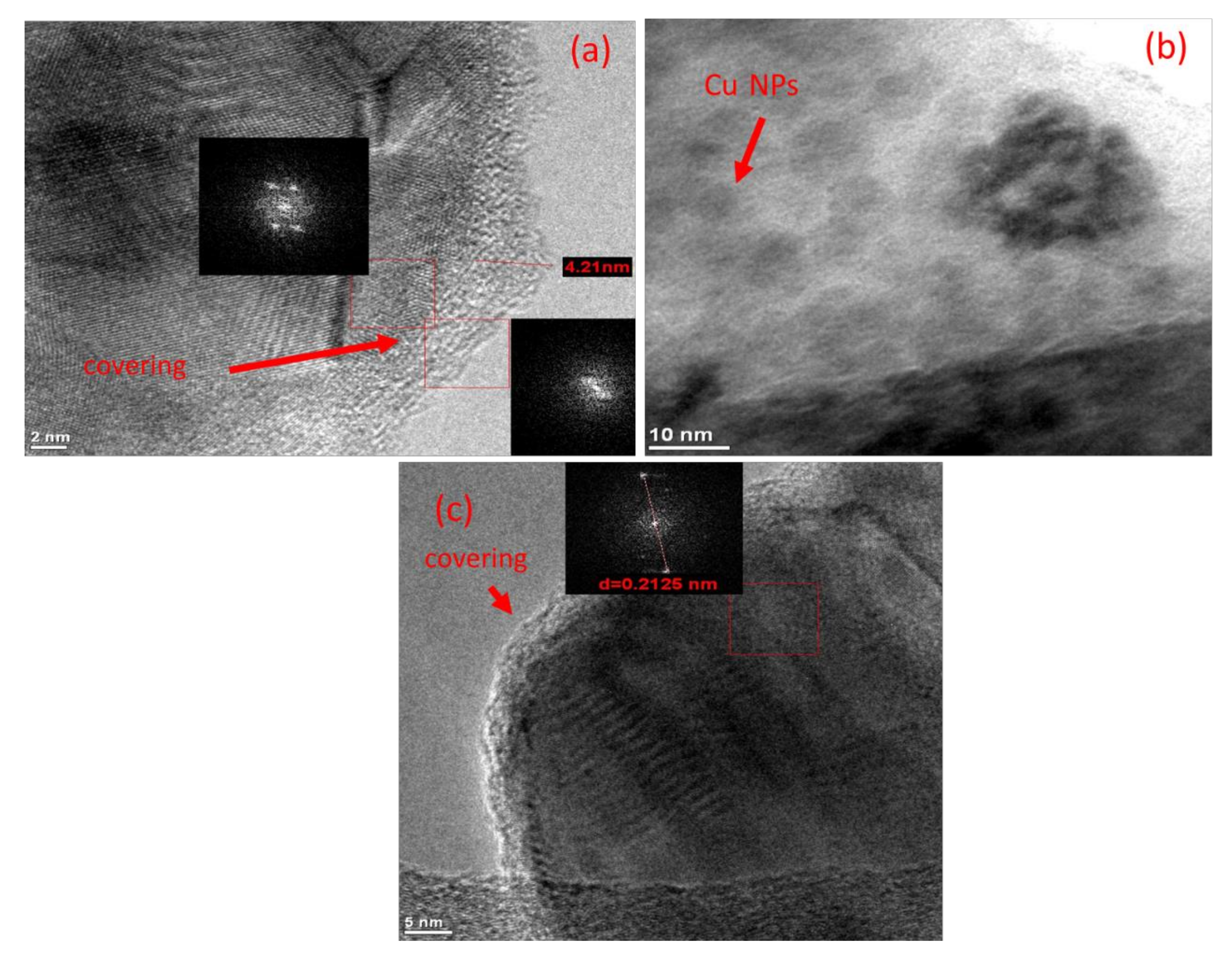

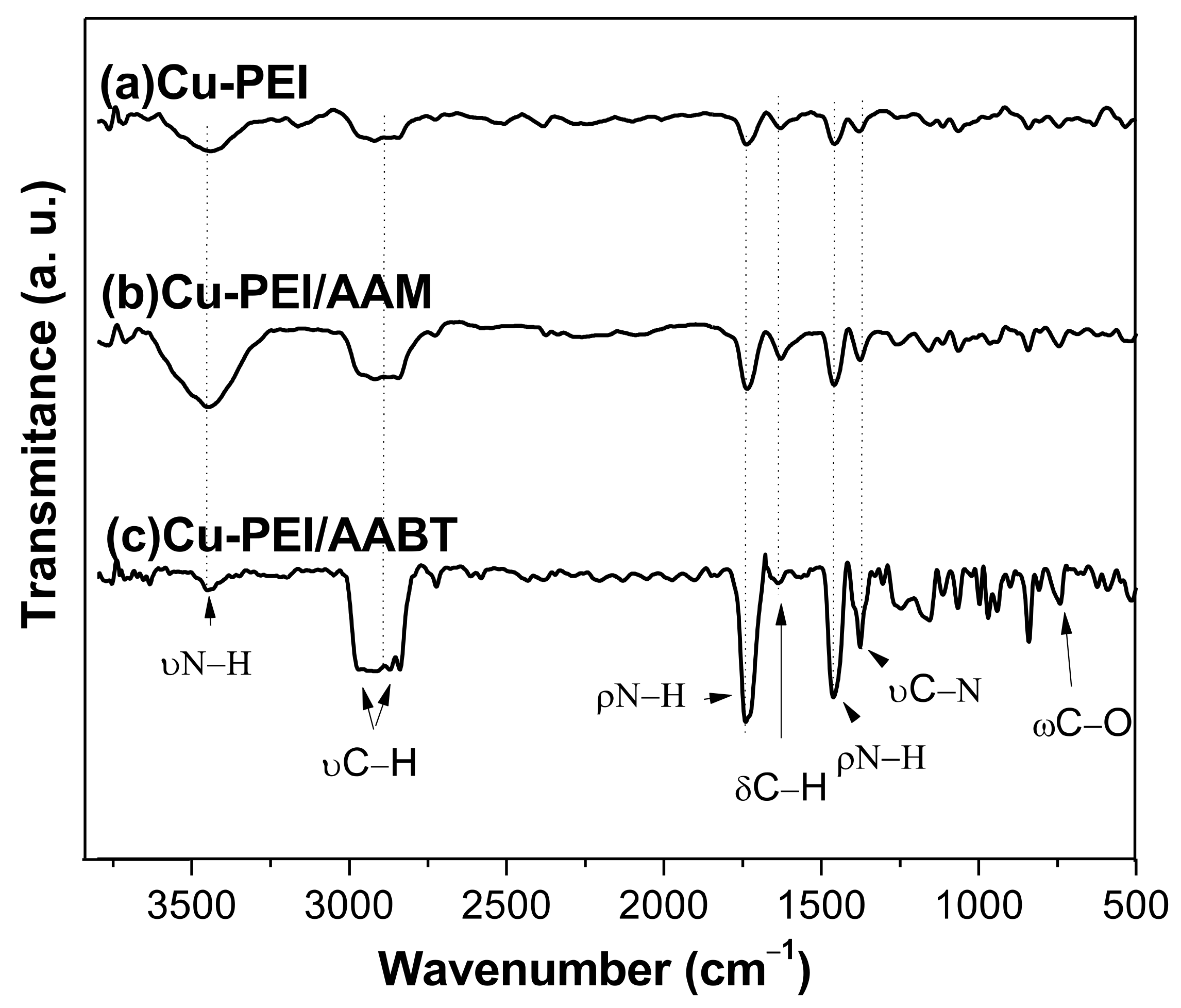
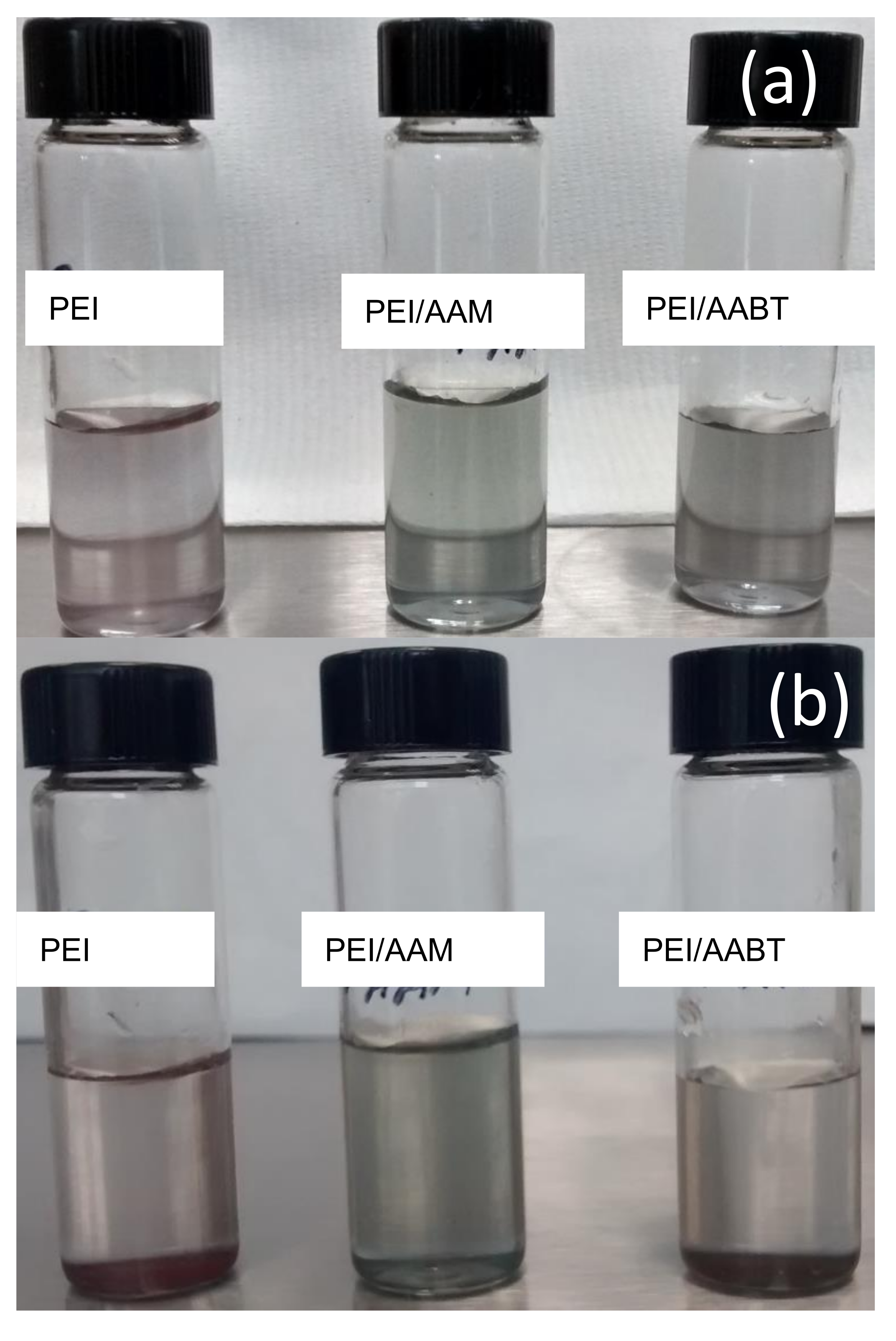
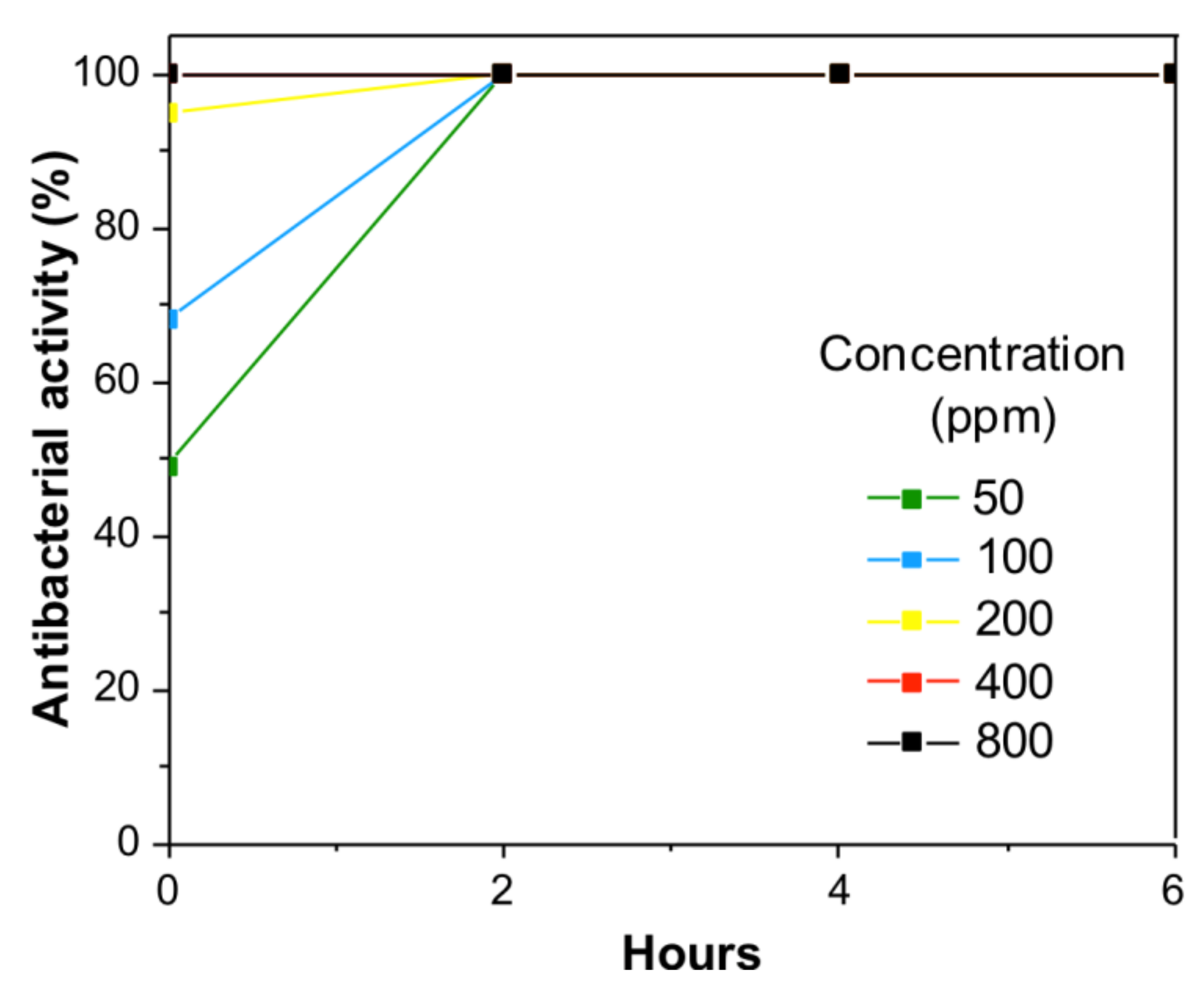

| Ligand | Cu a (%) | Yield (%) | Ligand a (%) | Average Particle Size b (nm) |
|---|---|---|---|---|
| PEI | 95.4 | 89.6 | 4.6 | 24.3 ± 0.4 |
| PEI/AABT | 91.3 | 90.9 | 8.7 | 26.6 ± 0.4 |
| PEI/AAM | 89.3 | 86.3 | 10.7 | 19.3 ± 0.4 |
| PAAm c | 96.8 | 86.0 | 3.2 | 24.0 ± 0.4 |
| AAM c | 94.4 | 36.0 | 5.6 | 30.0 ± 0.4 |
| PEI d | 87.5 | - | 12.5 | 8.5 |
| Assignment | PEI | AAM | AABT |
|---|---|---|---|
| Stretching N−H | 3360 | 3370 | 3380 |
| Stretching C–H | 2950 a | 2920 a | 2960 |
| 2830 s | 2840 s | 2940 | |
| Bending N–H | 1570 | 1670 | 1010 |
| 1310 | |||
| Bending C–H | 1480 | 1420 | 1400 |
| 1310 | |||
| Stretching C–N | 1120 | 1120 | 1120 |
| Stretching C=O | 1600 | ||
| C=C | 920 | ||
| Bending C–O | 789 | ||
| 648 |
Publisher’s Note: MDPI stays neutral with regard to jurisdictional claims in published maps and institutional affiliations. |
© 2021 by the authors. Licensee MDPI, Basel, Switzerland. This article is an open access article distributed under the terms and conditions of the Creative Commons Attribution (CC BY) license (https://creativecommons.org/licenses/by/4.0/).
Share and Cite
Jardón-Maximino, N.; Pérez-Alvarez, M.; Cadenas-Pliego, G.; Lugo-Uribe, L.E.; Cabello-Alvarado, C.; Mata-Padilla, J.M.; Barriga-Castro, E.D. Synthesis of Copper Nanoparticles Stabilized with Organic Ligands and Their Antimicrobial Properties. Polymers 2021, 13, 2846. https://doi.org/10.3390/polym13172846
Jardón-Maximino N, Pérez-Alvarez M, Cadenas-Pliego G, Lugo-Uribe LE, Cabello-Alvarado C, Mata-Padilla JM, Barriga-Castro ED. Synthesis of Copper Nanoparticles Stabilized with Organic Ligands and Their Antimicrobial Properties. Polymers. 2021; 13(17):2846. https://doi.org/10.3390/polym13172846
Chicago/Turabian StyleJardón-Maximino, Noemi, Marissa Pérez-Alvarez, Gregorio Cadenas-Pliego, Luis E. Lugo-Uribe, Christian Cabello-Alvarado, José M. Mata-Padilla, and Enrique Díaz Barriga-Castro. 2021. "Synthesis of Copper Nanoparticles Stabilized with Organic Ligands and Their Antimicrobial Properties" Polymers 13, no. 17: 2846. https://doi.org/10.3390/polym13172846





